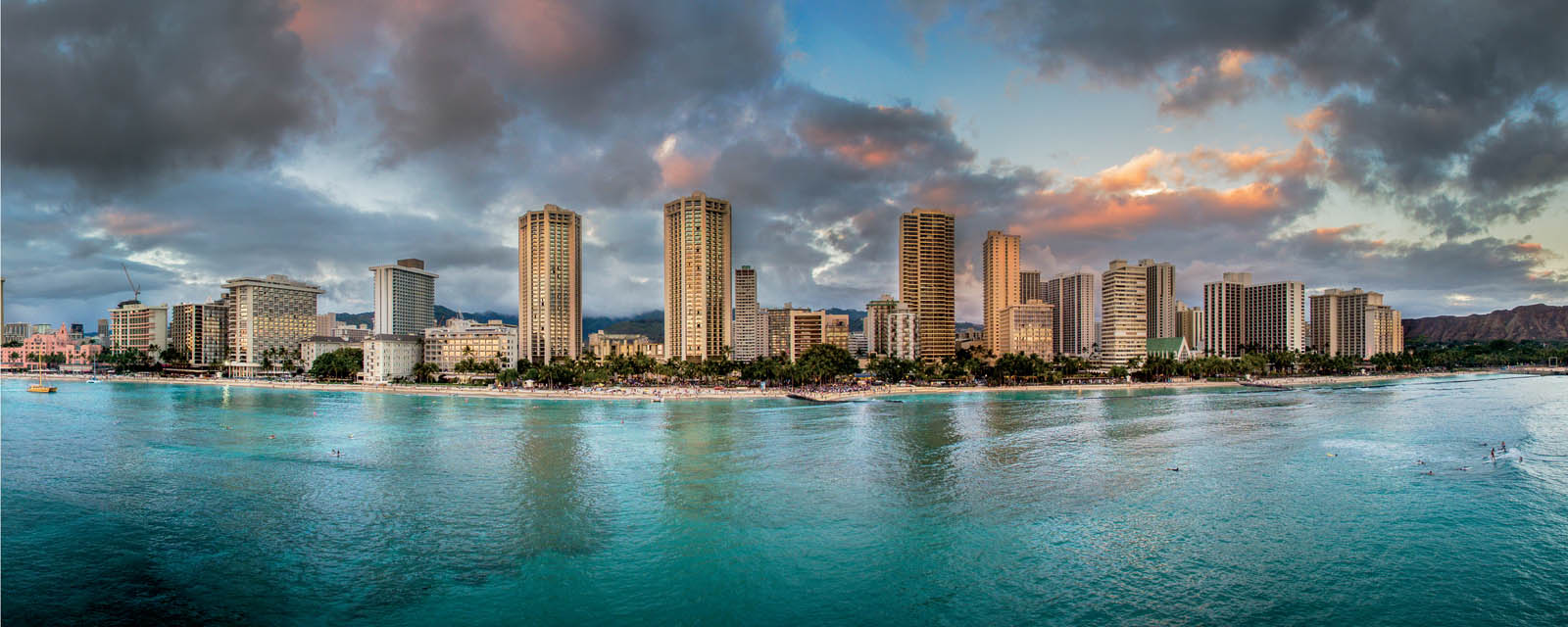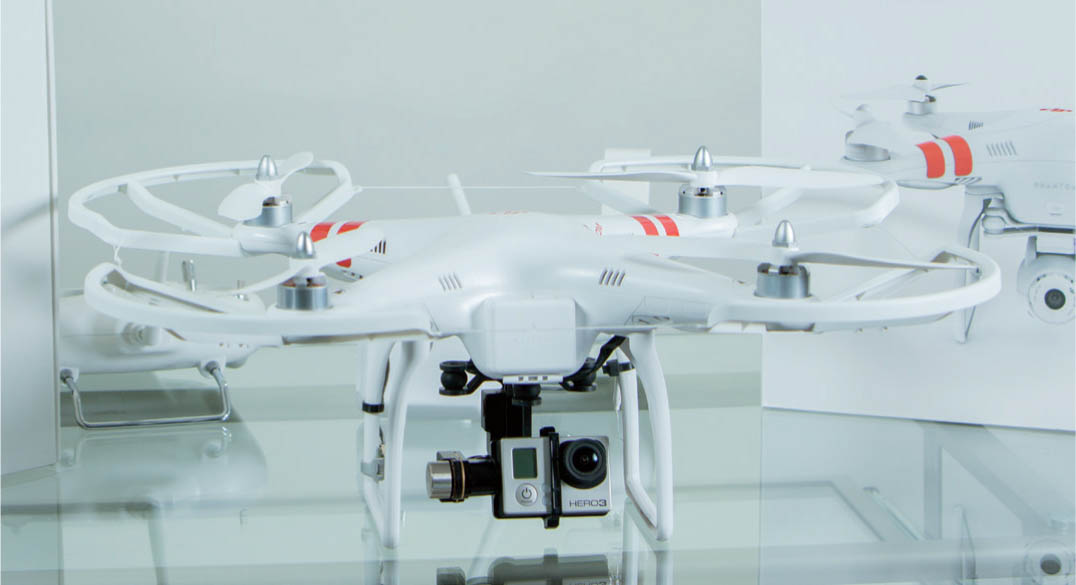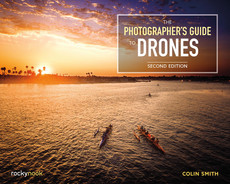
WAIKIKI BEACH, OAHU, HAWAII • JULY, 2015 DJI PHANTOM 3 PROFESSIONAL
This aerial panorama was shot from a low altitude, so the buildings appear against the sky. Shot from about 1200 feet away.
CHAPTER 1SAFETY AND REGULATIONS
SAFETY CERTAINLY ISN’T SEXY, but then again, neither is being sliced by a propeller. Safety is one of those subjects that no one wants to talk about until after an accident. I’m going to keep it short and sweet and give you a crash course on safety and regulations. Safety really is common sense, but I’m sure there are a few things you might not have thought about. Safety goes hand in hand with most current regulations. I’m not going to go into too many details about regulations, because each country has its own rules and regulations, and this information changes too quickly to commit it to a printed page. You need to find out the current rules for your country or region.
SAFETY
YOUR AIRBORNE CAMERA IS NOT A TOY. Spinning propellers and falling objects have the ability to injure people. Depending on the aircraft you have, you could injure or possibly kill someone if you aren’t using basic safety and common sense.
Preflight Safety
The first thing you want to do is create some kind of preflight safety check before flying. For instance:
- Are the batteries fully charged in your remote, your aircraft, and your FPV? Don’t be fooled by a half-charged battery. If it was subject to a smart discharge, there is less power than you think. A “half-charged” controller can run out of juice in just a few minutes if it’s been sitting for a while.
- Have you inspected your propellers for damage and made sure they are tightly secured?
- Are there any cracks or loose parts on your aircraft that could fall off during flight?
- Is your takeoff area open and free from obstructions such as trees and power lines? If there is a return to home failsafe, is there enough open space for an auto landing?
- Are you clear of people and animals for takeoff and landing? While it may be fun to have an audience, if there are too many interested people, unsupervised children, or dogs, it might be a good idea to find a different location to fly.
- Is it too windy or wet for safe flying? How is visibility?
- Are you near an airport? (See the “Regulations” section.)
- Are you near large metal structures? These structures have been known to cause interference with the compass, resulting in erratic flying.
- Have you calibrated your compass?
When starting up your aircraft, always turn on the controller before the aircraft, and always shut off the aircraft before turning off the controller. It’s important to never have your aircraft on unless the controller is on. If the aircraft grabs a rogue signal and your controller isn’t on, you have no way to control the aircraft to bring it back on course.
Make sure you have the latest firmware running (more about this in the next chapter). Whenever doing a firmware update, leave the propellers off. This is the only time you will turn on your aircraft without the controller being on.
In-Flight Safety
If you take off in a gusty breeze, always stand upwind. That way, if your copter blows over, it will blow away from you and not into you. I have heard people say that you should fly into the wind for lift. This may be true for fixed-wing aircraft (it’s why an aircraft carrier turns into the wind for takeoff), but a multi-copter drone, generally has poor aerodynamics and is VTOL (vertical takeoff and landing), so there is no benefit to flying into the wind. Unless you strike an obstacle, crashes and tip-overs are most likely during takeoff and landing. Once airborne, it’s extremely unlikely you will lose control and crash.
What’s a tip-over? Just before your aircraft lifts, or during landing, its props are spinning fast and it’s very light on its feet. Sometimes it can tip over and run along the ground. If you are standing upwind, a tip-over isn’t really a safety threat as much as an annoyance, since your props can get scuffed or cracked. I wouldn’t call this a crash, because tip-overs happen all the time, even to experienced pilots.
When you are airborne and at a lower altitude, but clear of obstacles and people’s heads, quickly run through each control to make sure everything is responding correctly. Ascend and descend slightly, bank forward and backward, roll left and right, yaw left and right. Do small movements just to make sure everything is OK. Don’t worry, these terms are explained in the next chapter.
Always be aware of your environment. Take note of potential hazards and obstacles before takeoff, and constantly keep an eye out and know what is happening around you. If you hear a manned aircraft, try to see where it is. If you can’t locate the manned aircraft, immediately descend to a low altitude or land the drone. Some drones will show the manned aircraft on your map in the flight app.
If you see any emergency vehicles or helicopters, land immediately and don’t fly until you know that you aren’t interfering with emergency operations. Resist the urge to “help out”; they don’t need your help. It’s best to stay out of the way and let the trained professionals do their jobs.
There are simple common sense rules like “don’t put your fingers into spinning props.” While copters like the Phantom and Mavic are unlikely to sever a limb, they can cause pain and bleeding from deep scratches. Carbon fiber props are another issue altogether. While some pilots say they make for smoother flights, they are essentially turning their plastic props into spinning knives. You can be injured by spinning props even if the motors aren’t running. If you get enough of a breeze, it can spin the props like a windmill. It might seem novel, but as I personally found out, propellors spinning with just a breeze can be quite painful if you get your hands near them. If you do see the wind spinning your props, tilt the drone at an angle, so it doesn’t happen, or carry it against your body, so that the props can’t spin. If you are using a folding drone, such as a Mavic, keep it folded until you are ready for flight check.
Larger crafts such as the Inspire are capable of a lot more damage with their propellers. Just search online for pop singer Enrique Iglesias grabbing an Inspire 1 during one of his concerts. What was he thinking?
Propeller Guards
Propeller guards are another option you can use to increase safety. Prop guards are inexpensive and provide a plastic shield around the propeller area. Usually string is tied between each guard to create an all-around bumper. If you are flying indoors, prop guards aren’t a problem. Instead of colliding with obstacles, you can bounce off some of them. But I’ve seen quite a few quadcopters with prop guards run up a wall and damage it.
Outdoors, prop guards can be helpful. It’s possible to bounce off a tree or nudge by it without crashing. Without prop guards, your propellers might stop if they hit an obstacle. When the props stop, your whole craft will fall from the sky. Some hexacopters (six props) and can still fly if an engine quits.
If you’re a beginner, it’s not a bad idea to use prop guards (think of them as training wheels). They could prevent crashes and give you a little more confidence. Some pros use prop guards because of the extra level of safety. The downside is that the guards can get in your shots, so you need to fly more slowly, or point the camera a little lower than usual.
Attacks by Seagulls
Gulls can be very aggressive and territorial birds, especially during nesting. You will hear them squawking and swooping near your drone. Generally, they won’t make contact with your copter, but it’s possible. I have personally experienced a seagull purposely knock a small drone (DJI Spark) out of the sky. This small drone went straight into the ocean, never to be seen again.

1.1 Prop guards on an original Phantom
I have found that if you fly away horizontally, they will chase you for a decent distance. The easiest way to shake them is to climb to a higher altitude. They seem to like low altitudes close to their nests and food sources and will leave you alone pretty quickly when you climb higher.
Other Safety Concerns
Some of these are rules, some are proposed rules, and some are common sense.
Are you in restricted airspace or a TNFZ (temporary no-fly zone)? Apps such as Hover or the FAA’s B4Ufly can help you know where you are allowed to fly. This could be because of an emergency, presidential visit, or other reasons. The penalties can be quite stiff for violating a TNFZ.
REGULATIONS
I AM NOT A LAWYER, AND NONE OF THIS IS LEGAL ADVICE. The rules and regulations are constantly evolving. Because of this, some of this information may have changed since the time of this writing. Also bear in mind that rules are different in different regions and countries. I suggest becoming familiar with your local laws.
The best place to start is with your civil aviation authority website (USA=FAA, Canada=TC, UK=CCA, New Zealand=CAA, Australia=CAS, China=CAAC, and so on). Some countries have tighter restrictions than others. Some rules are common among most countries. I am going to list the basic rules for the USA, and most of these rules are common throughout the world, with some variances. These rules are for people flying aircraft less than 55 pounds.
- Don’t fly over 400 feet.
- Always keep a visual line of sight. You have to be able to see the aircraft at all times with your eyes, not with binoculars or FPV.
- Stay away from all manned flight operations. They have the right of way, and it’s your responsibility to get out of their way. Often, you can see them but they can’t see you.
- No flying over stadiums or crowds of people.
- If you are planning to fly within five miles of an airport, you need to call the control tower first.
- No flying under the influence of alcohol or drugs. (Although this is technically a safety “guideline” right now.) Either way, no good can come from an intoxicated flyer.
- No dangerous or reckless flying.
Recreational Flyer
In the USA, there are two types of pilots: recreational and commercial.
The definition of a recreational flyer is: “A recreational flyer is someone who operates their drone for fun or personal enjoyment purposes only.” This is what we call a hobbyist.
How to Fly a Drone Recreationally
- Pass TRUST.
- If your drone weighs more than .55 pounds, register your drone through the FAA’s DroneZone.
- Follow safety guidelines on the FAA website or of an existing aeromodelling organization. For example, AMA.
TRUST Test
In the United States, you need to pass The Recreational UAS Safety Test (TRUST) before you can fly as a recreational pilot. Links to the test are provided on the FAA website: https://www.faa.gov/uas/recreational_fliers/knowledge_test_updates/
You need to take a quick course and pass a simple knowledge test. This is free and should take approximately 30 minutes to an hour. After you complete the test, print out the certificate and carry it with you while flying. You could be asked to show it to FAA or law enforcement. I save a digital copy of the PDF on my phone, so it’s always handy.
Registration
Some countries require you to register your UAS/UAV/drone with the government. In the United States, you have to register anything that weighs between 0.55 pounds and 55 pounds before flying. Register at www.registermyuas.faa.gov. This is the official place to register. It’s quick and painless. You provide some personal information and pay a $5 fee, and you need to renew every three years. Beware of anyone charging other fees to register and beware of other sites.
You will receive an F-number immediately upon registering, along with a certificate. This number has to be attached to all of your aircraft. If you have multiple drones, you will use the same number on them all, you don’t have to register each aircraft separately.
The rules used to say the number has to be accessible without the use of tools. You used to be allowed to keep the number inside the battery compartment. The rules have now changed, and the number needs to be visible on the outside of your drone. Also print out and carry your registration card or keep a digital copy handy.
Commercial Use
Perhaps you plan on using your drone for commercial purposes. The FAA states flying for any purpose other than for enjoyment is commercial.
Part 107
If you desire to fly commercially, you must be a FAA-Certified Remote Pilot. You will need to get a Part 107 certificate.
You will need to complete the knowledge test. There are schools and online courses that can help you with this test. Once you have a Part 107, you are able to fly with certain limitations. Some of these limitations can be bypassed with a special waiver, such as increased range (VLOS waiver), altitude, flying from a moving vehicle, and others. I won’t list them all here, because they are always changing, so check out the FAA website for these details.

1.2 Registration card in email
CONCLUSION
ABOVE ALL, FOLLOW THE LOCAL RULES, USE COMMON SENSE, AND PUT SAFETY FIRST. If you are confronted by local authorities and asked to land and stop flying, I suggest you do as they ask, even if they are wrong. You will never win an argument with law enforcement or security, and no good will come from agitating people. Either fly at a different location or come back with written proof that you can fly there.
If you think that something is unsafe, or you are nervous about your ability to perform a maneuver, don’t try it. No shot is worth risking your safety or your expensive equipment.
